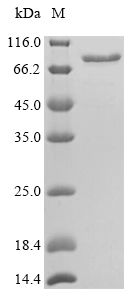This Recombinant Mouse Calr protein was made through genetic engineering. By putting the Calr gene into the genetic material of E.coli cell, the E.coli could be used as factories or producers to make the desired Calr protein for research uses. The expression region of this protein is at 18-416aa. N-terminal GST tag was used in the expression process. The purity is 90%+ determined by SDS-PAGE.
Calreticulin (CALR) is a Ca2+-binding endoplasmic reticulum (ER) protein that aids the folding of proteins destined to secretion and insertion in the plasma membrane, de facto providing a major contribution to the maintenance of cellular homeostasis when unfolded proteins accumulate within the ER (e.g., in the context of viral infection). Moreover, CALR mechanistically contributes to the initiation of adaptive anticancer immunity in the context of immunogenic cell death (ICD), a functional variant of regulated cell death (RCD) that is sufficient to elicit an antigen-specific immune response in immunocompetent, syngeneic hosts (provided that dying cells express antigens not covered by central or peripheral tolerance). In particular, CALR exposed on the surface of cancer cells undergoing ICD mediates robust pro-phagocytic effects, hence facilitating the uptake of dying cells or their corpses by antigen-presenting cells (APCs), in particular immature dendritic cells (DCs), which migrate to lymph nodes to cross-prime tumors specific naïve CD8+ T cells.






